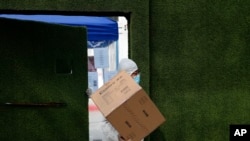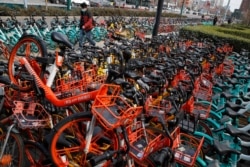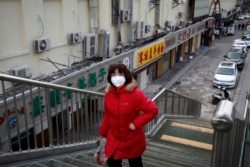As Chinese authorities try to get the country back to work without risking another coronavirus outbreak, new official data show that the manufacturing sector plunged by a wider margin than expected.
A private, independent survey manufacturers published Monday showed the steepest decline in China's manufacturing activity in 16 years. The Caixin/Markit Manufacturing Purchasing Managers' Index (PMI), which gives an independent snapshot of operating conditions in the manufacturing sector, fell last month to 40.3, the lowest reading since the survey began in April 2004. A PMI rating below 50 indicates that the manufacturing economy is declining, while a value above 50 signals manufacturing economic expansion.
Last Saturday, China's National Bureau of Statistics (NBS) revealed that the widely-watched indicator of the country's economic activity slumped to a record low of 35.7 in February from 50.0 in January. This was the lowest since January 2005, when the index was first released. The previous lowest was 38.8 in November 2008, during the international financial crisis.
In addition to the manufacturing data, China's non-manufacturing services sector activity also posted its deepest contraction on record, dropping to 29.6 from 54.1 in January, according to another survey by China's NBS.
The surveys provide the first snapshots of the state of the Chinese economy since the coronavirus outbreak in early January.
'Shocking' declines
The declines were widely anticipated after the extended Lunar New Year holiday kept factories and offices closed, but the figures were even more severe than many forecasters expected. Analysts polled by Bloomberg and Reuters had expected the February PMI reading to come in between 45.0 and 46.0. A reading below 50 indicates a contraction in sector activity.
"It is shocking," Dr. Frank Xie, a business professor at the University of South Carolina Aiken, said of how wrong analysts were in predictiing the severity of the economic blow to Chinese businesses and industries. "It really shows how bad the situation is," he said of the latest reports.
Nicholas R. Lardy, an economist at the Brookings Institution who has written numerous articles and books on the Chinese economy, also pointed out that the actual damage could be much worse.
"I think the negative effect of the virus on China's economy is going to be much larger than some think," Lardy said. He said that although many businesses have reported reopening, they are operating at a low level of activity because their workers have not returned or they can't get supplies or ship the final output they produce.
Small businesses struggle
While the coronavirus epidemic has disrupted business for some of the biggest corporations in the world, it is hitting smaller businesses in China particularly hard.
A report by the central government supervisory body says 90 percent of state firms are now back in business. China's state assets oversight agency, the State Council's Assets Supervision and Administration Commission, said on Sunday that the 48,000 subsidiaries under the government-owned firms supervised by the oversight agency have reported a 91.7 percent work resumption rate.
By contrast, the deputy minister of the Ministry of Industry and Information Technology, Zhang Kejian, said last Wednesday that only 30 percent of China's small- and medium-sized enterprises had resumed work.
The Chinese Association of Small and Medium Enterprises said Sunday that pace of resumption is very slow, with many factories still not reopened.
The newly released PMI index, which comes from a list of questions sent to hundreds of manufacturers, gives details about companies' purchasing activities and supply situations, and shows that small businesses are being hard hit by the virus outbreak.
Small- and medium-sized businesses contribute more than 60% of the country's Gross Domestic Product, and they employ more than 80% of China's workers, according to government statistics published last September.
Government support
A small business owner with the last name Wu in Wenzhou, one of the country's top manufacturing bases, told VOA that his employees have not returned at all.
"Without any orders coming in it would be pointless" for my employees come back to work, Wu said.
Wu opened his shoe manufacturing business about 15 years ago and it had been doing well until now, he said. He normally has about 30 employees, most of them from other parts of China.
He said that he has only ventured out once or twice a week since the lockdown and has not been to his factory at all.
"My customers are not able to come to me. Now I can only use apps to handle some orders on Taobao," an Amazon-like online marketplace, he said.
A survey of small- and medium-sized businesses conducted by the Chinese Association of Small and Medium Enterprises last week found that over 85% of respondents believe they will run out of cash in less than three months, and about 60% could cover regular payments for only one to two months before running out of cash.
Recognizing the threat, the government has pledged support for the country's small- and medium-sized businesses, including a deferral of pension, health and housing payments, and promises to lower rents. The government has also announced delayed schedules for repaying business loans.
Health crisis challenges
In recent days, China has reported only single-digit new confirmed cases outside Hubei Province. But the government is not ready to declare victory yet. Liang Wannian, a senior official with China's National Health Commission, said last Saturday that "the situation is still very grim. We haven't stopped the epidemic in Wuhan yet."
Many analysts agree it is too early to celebrate given the highly contagious nature of the virus and the potential for a new surge in cases when millions of people go back to work in China.
"The current situation is still volatile and a resurgence in confirmed cases and deaths is just as likely," said Ross Darrell Feingold, a political risk analyst who advises multinational corporations doing business in China.
The government now has a multi-faceted challenge before the restart of operations can reach a scale to prevent a sustained economic slowdown. These challenges include safely
transporting sufficient amounts of labor to their place of work, ensuring that the factory floor and worker dormitories have adequate safety protocols, and trying to restart the country's stalled logistics pipeline that moves billions of products from factory floors to retail shops in China and around the world.
"Low interest loans, fee waivers, and other such financial incentives for manufacturers won't address these challenges, because the main issue remains a public health crisis that requires a medical solution," Feingold said.











